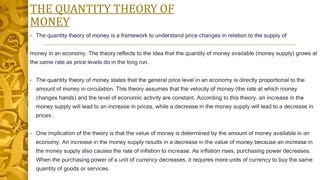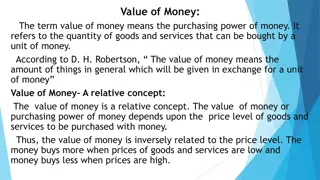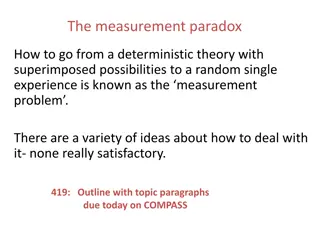The Liar Paradox and Money Creation
Delve into the intriguing concept of the Liar Paradox through the lens of Bertrand Russell's mathematical insights. Explore the origins and evolution of money, from its creation to its role as a store of wealth and medium of exchange. Uncover the complexities of numbers and their definitions, alongside the fascinating interplay between fiduciary money and betrayal in societal wealth accumulation.
Download Presentation

Please find below an Image/Link to download the presentation.
The content on the website is provided AS IS for your information and personal use only. It may not be sold, licensed, or shared on other websites without obtaining consent from the author.If you encounter any issues during the download, it is possible that the publisher has removed the file from their server.
You are allowed to download the files provided on this website for personal or commercial use, subject to the condition that they are used lawfully. All files are the property of their respective owners.
The content on the website is provided AS IS for your information and personal use only. It may not be sold, licensed, or shared on other websites without obtaining consent from the author.
E N D
Presentation Transcript
Dr. Muzaffar Ahmad Dar Dr. Muzaffar Ahmad Dar
Fundamental analysis, in accounting and finance, is the analysis of a business's financial statements (usually to analyze the business's assets, liabilities, and earnings); health; and competitors and markets. It also considers the overall state of the economy and factors including interest rates, production, earnings, employment, GDP, housing, manufacturing and management. Fundamental analysis is a method of determining a stock's real or "fair market" value. Fundamental analysts search for stocks currently trading at prices higher or lower than their real value. If the fair market value is higher than the market price, the stock is deemed undervalued, and a buy recommendation is given. If the fair market value is lower than the market price, the stock is deemed overvalued, and the recommendation might be not to buy or to sell if the stock is held. There are two basic methodologies investors rely upon when the objective of the analysis is to determine what stock to buy and at what price.
Fundamental analysis is performed on historical and present data, but with the goal of making financial forecasts. There are several possible objectives: to conduct a company stock valuation and predict its probable price evolution; to make a projection on its business performance; to evaluate its management and make internal business decisions and/or to calculate its credit risk to find out the intrinsic value of the share. Fundamental analysis historical data publicly known information announcements made by the management and what others say about the company information that is not known publicly how the leadership handles crises, situations, etc. Fundamental analysis uses three sets of data historical data to check how things were in the past publicly known information about the company, including uses three sets of data: information that is not known publicly but is useful, i.e.,
Fundamental analysis of a company helps you get to its stock s fair price, which may not always be trading at its fair value. Often it is overpriced or underrated. Fundamental analysis helps in predicting the long-term trends in the market. It is generally used for long-term investments as it enables you to understand the price that the stock should reach. It also allows you to find good companies for investment, such as those with strong growth potential. Additionally, the analysis helps with one of the most critical but intangible factors business acumen, which is highly beneficial in investment analysis as it can tell you about the future of the business.
There are two main types of fundamental analysis Qualitative: a study that involves brand value, management decisions, the financial performance of the company over a given period, and other similar factors. Quantitative: an analysis that is purely number-based and considers the company s financial statements and concludes the share price from the observations. Though the approaches are different, they are equally crucial for a comprehensive analysis of a company s share price. There are also two processes of fundamental analysis. One is top- down, and the other is a bottom-up approach. The top-down approach looks into the macroeconomic factors first and then digs into the specific company. On the other hand, the bottom-up approach analyses the company first and then checks the effect of macroeconomic factors on the company s performance.
Basics Before conducting fundamental analysis of a stock, you need to consider a few basic factors. These factors are Company s structure and revenue Company s profits over the years Revenue growth over the years Company s debt Corporate governance Rate of turnover Analysts look at these six factors while conducting a fundamental analysis of any security and determine its intrinsic value. Basics of of Fundamental Fundamental Analysis Analysis
Fundamental analysis also has certain drawbacks: It could take a long time to pay off While fundamental analysis might help you identify companies that have been overpriced or underpriced, it won't necessarily reveal the likely timescale before the share price moves in line with your assessment. So unlike technical analysis, where the moment to buy or sell can often be predicted on a chart, there's no way of knowing how long it might take to secure a profit. No two sectors are the same The way you assess a company's value will depend on the sector it belongs to. This means each time you look at a new company in an unfamiliar sector, you'll probably need to use a different approach altogether. This may mean, in the interests of time, you'll need to restrict yourself to just one or two sectors. Objectivity can be impossible When calculating the fair value of a company, you often have to make assumptions about variable factors: interest rate expectations, for example, or government taxation policy. But these assumptions are, by nature, entirely subjective. The most you can do is to consider multiple scenarios and outcomes, to allow for the fact that your view may be overly optimistic or cynical. Companies spin their own news Most of the information fundamental analysts use to assess a company comes from the company itself. By hiring investor relations managers, these businesses ensure any releases reflect as positively on their performance as possible. It's worth bearing this in mind and taking their announcements with a little pinch of salt.
Technical analysis is a trading discipline employed to evaluate investments and identify trading opportunities by analyzing statistical trends gathered from trading activity, such as price movement and volume. Unlike fundamental analysis, which attempts to evaluate a security's value based on business results such as sales and earnings, technical analysis focuses on the study of price and volume. Technical analysis tools are used to scrutinize the ways supply and demand for a security will affect changes in price, volume, and implied volatility. It operates from the assumption that past trading activity and price changes of a security can be valuable indicators of the security's future price movements when paired with appropriate investing or trading rules. Technical analysis has three main principles and assumptions: (1) The market discounts everything (2) prices move in trends and countertrends, and (3) price action is repetitive, with certain patterns reoccurring.
There are certain important theories of technical analysis that are helpful in conducting technical analysis of the market. These include Dow Theory Fibonacci Numbers Kondratev Wave Theory Chaos Theory Neural Networks
One of the founders of Dow Jones & Co. was Charles Dow. He is also sometimes considered as the inventor of point & figure chart. According to Dow Theory, movement of stock prices includes three components. The most important one is the primary trend which represents the long term direction of the market. This primary trend indicates the terms bull & bear. The temporary reversal in the primary trend is referred to as secondary trend. The secondary trend does not continue for a long term and due to this reason it cannot become primary trend. The third component includes daily fluctuations in the prices of stock which does not contain any useful information and are meaningless. Ocean analogy is mostly used as an illustration for the Dow Theory. The tide in the ocean is either coming in or going out which reflect the primary trend. When there tide going out, the waves still wash ashore which is representation of secondary trend. In certain situation ripples are produced from the waves that reach the sand with no apparent reason and soak the things on the sand.
The price movements of Dow Jones Industrial Average provide the basis for Dow Theory. Dow Jones Transportation Average confirms the changes in the primary trend of the DJIA. The logic is that the products are manufactured by industrial companies & shipped by transportation companies. The economy is in good shape when both averages are advancing. The technical points of this famous market technique are better explained in the books in most public libraries. The Dow Theory was not much developed by the Charles Dow. It is suggested by the Wall Street Journal that distortion & selective editing of ideas of Mr. Dow provides the basis for the entire field of the technical analysis. It is argued by another financial historian that Dow Theory only explains the statistical nature of trends from the averages. Also the Dow did not suggest the prediction of price through interpretation of charts.
The Elliott wave principle, or Elliott wave theory, is a form of technical analysis that finance traders use to analyze financial market cycles and forecast market trends by identifying extremes in investor psychology and price levels, such as highs and lows, by looking for patterns in prices. The Elliott wave principle states that markets grow from small price movements by linking Elliot wave patterns to form larger five-wave and three-wave structures that exhibit self-similarity, applicable on all timescales. Each level of such timescales is called the degree of the wave, or price pattern. In Elliott's theory, market prices alternate between an impulsive, or motive, phase, and a corrective phase on all time scales of trend, as the illustration shows. Impulses are always subdivided into a set of five lower-degree waves, alternating again between motive and corrective character, so that waves 1, 3, and 5 are impulses, and waves 2 and 4 are smaller retraces of waves 1 and 3, respectively. Corrective waves subdivide into three smaller-degree waves starting with a five-wave counter-trend impulse, a retrace, and another impulse. In a bear market the dominant trend is downward, and the pattern is reversed five waves down and three up. Motive waves always move with the trend, while corrective waves move against it.
The random walk hypothesis is a financial theory stating that stock market prices evolve according to a random walk (so price changes are random) and thus cannot be predicted. Random walk theory suggests that changes in asset prices are random. This means that stock prices move unpredictably, so that past prices cannot be used to accurately predict future prices. Random walk theory also implies that the stock market is efficient and reflects all available information. A random walk challenges the idea that traders can time the market or use technical analysis to identify and profit from patterns or trends in stock prices. Random walk has been criticized by some traders and analysts who believe that stock prices can be predicted using various methods, like technical analysis.
Fundamental Analysis and Technical Analysis are two distinct methods used to analyze and make investment decisions in financial markets, particularly in stocks and other securities. They approach the evaluation of investments from different perspectives and utilize different types of information. Here's a breakdown of their differences: Fundamental Analysis: Fundamental analysis involves evaluating the intrinsic value of a security by analyzing various factors related to the underlying company's financial health, operations, industry, and overall economic environment. The goal is to determine whether a security is overvalued or undervalued based on its fundamentals. Key Aspects: Financial Statements: Fundamental analysis heavily relies on a company's financial statements, including its balance sheet, income statement, and cash flow statement. These documents provide insights into a company's revenue, expenses, profits, and overall financial health. Earnings and Revenue: Analysts focus on the company's earnings growth and revenue trends over time. They assess factors such as profitability, profit margins, and earnings per share (EPS). Valuation Ratios: Metrics like price-to-earnings ratio (P/E), price-to-book ratio (P/B), and dividend yield are used to assess whether a stock is overvalued or undervalued relative to its peers or historical averages. Industry and Market Analysis: Fundamental analysis also considers broader economic and industry trends that can impact a company's performance.
Technical Analysis: Technical analysis involves studying past market data, primarily price and trading volume, to predict future price movements of a security. It relies on the idea that market trends tend to repeat and that historical price patterns can help predict future price movements. Key Aspects: Price Charts: Technical analysts use price charts, such as line charts, bar charts, and candlestick charts, to identify patterns and trends in price movements. Indicators and Oscillators: Technical analysis employs various indicators and oscillators, such as moving averages, Relative Strength Index (RSI), and Moving Average Convergence Divergence (MACD), to provide signals for potential price reversals or trends. Support and Resistance Levels:Analysts identify levels where a security's price has historically struggled to rise above (resistance) or fall below (support). These levels are seen as significant in predicting future price movements. Volume Analysis: Trading volume is considered as an indicator of market sentiment. Changes in trading volume are analyzed to gauge the strength of price trends.
Approach: Fundamental analysis looks at the underlying factors of a company, such as financials and economic conditions, to determine its intrinsic value. Technical analysis focuses on historical price and volume data to predict future price movements. Data Used: Fundamental analysis relies on company financial statements, economic indicators, and industry trends. Technical analysis relies on historical price and volume data. Time Horizon: Fundamental analysis is often used for long-term investment decisions. Technical analysis is more commonly associated with short- to medium-term trading. Prediction Focus: Fundamental analysis aims to determine whether a security is overvalued or undervalued based on its underlying fundamentals. Technical analysis aims to identify patterns and trends in price movements to predict short-term price changes. Use Cases: Fundamental analysis is commonly used by value investors seeking to identify stocks that are trading below their intrinsic value. Technical analysis is often used by traders who seek to capitalize on short-term price movements and trends. Both approaches have their strengths and limitations, and some investors and traders choose to use a combination of both methods to make more informed investment decisions.
The Efficient Market Hypothesis (EMH) is a theory in finance that suggests that financial markets are efficient and that all available information is quickly and accurately reflected in security prices. In other words, the prices of financial assets, such as stocks, bonds, and commodities, already incorporate all publicly available information, making it difficult for investors to consistently outperform the market through stock picking or market timing. The EMH was developed in the 1960s and has been a significant concept in modern finance. It has three main forms: Weak Form Efficient Market Hypothesis: In this form, the hypothesis states that current stock prices already reflect all historical price and trading volume information. This means that past price movements or trading patterns cannot be used to predict future price movements since all that information is already factored into the current price. Semi-Strong Form Efficient Market Hypothesis: This form asserts that stock prices already incorporate not only historical price and volume information but also all publicly available information, including news, financial reports, and other market-related information. Therefore, it suggests that even detailed analysis of public information cannot lead to consistently superior investment returns, as any new information is quickly absorbed by the market. Strong Form Efficient Market Hypothesis: The strongest version of the EMH suggests that stock prices incorporate all information, including public and private information. This means that even insider information would not give an investor an advantage, as it is already reflected in the stock price.























